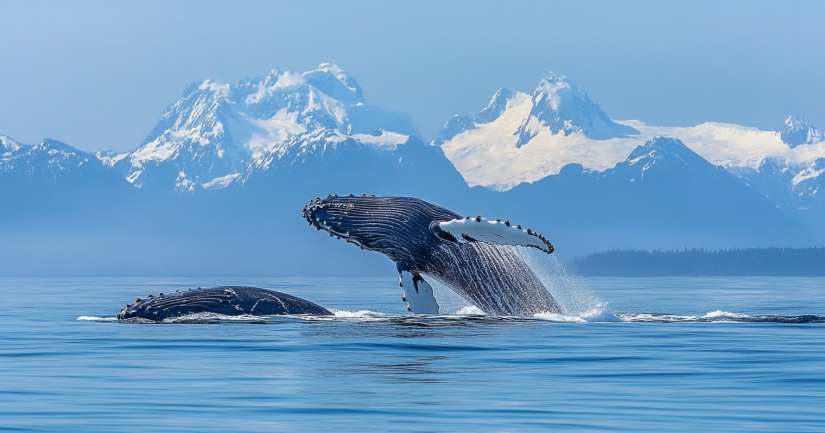
Humpback Whale Trivia, Test Your Knowledge of These Ocean Giants! Few creatures are as awe-inspiring as the humpback whale, the majestic marine mammal known for its massive size, haunting songs, and breathtaking acrobatics. These gentle giants travel thousands of miles across the ocean, breaching, tail-slapping, and singing in ways that continue to amaze scientists and whale watchers alike. But how much do you really know about humpback whales? Take our Humpback Whale Trivia Quiz and dive deep into the world of these incredible ocean wanderers!
Humpback Whales Sing Complex Songs Male humpbacks produce some of the longest and most intricate songs in the animal kingdom, which can last 20 minutes or more and travel for miles underwater.
Humpback whales belong to the baleen whale family and are known for their long migrations, complex vocalizations, and social behavior. Unlike their massive cousins, the blue whale and fin whale, humpbacks are famous for their playful, energetic movements, often leaping out of the water in spectacular breaches or slapping their massive fins against the surface.
Enjoyed learning about humpbacks? Unearth the secrets of the humble hermit crab in our Hermit Crab Trivia or explore vibrant marine ecosystems in our Coral Quiz.
What Makes Humpback Whales So Unique?
Mind-Blowing Humpback Whale Facts That Might Surprise You
- They Migrate Thousands of Miles – Humpbacks undertake one of the longest migrations of any mammal, traveling up to 5,000 miles (8,000 km) between feeding grounds in polar waters and warm breeding areas in the tropics.
- Each Humpback Whale Has a Unique Tail Pattern – Their fluke (tail) markings are as unique as a human fingerprint, allowing researchers to identify individual whales across the world’s oceans.
- They Use Bubble Nets to Trap Prey – Humpbacks work together to create bubble net traps, where they blow spirals of bubbles around schools of fish, forcing them to the surface before lunging up with open mouths.
- They Are Among the Most Acrobatic Whales – Despite weighing up to 40 tons, humpbacks frequently breach, twist, and splash, using their powerful tails and fins in spectacular aerial displays.
- A Single Humpback Can Eat Over 3,000 Pounds of Food a Day – They primarily feed on krill, small fish, and plankton, using their baleen plates to filter enormous amounts of prey.
- Humpbacks Were Nearly Hunted to Extinction – During the commercial whaling era, their populations plummeted, but thanks to global conservation efforts, they have made a dramatic comeback in recent decades.
The Role of Humpback Whales in Marine Ecosystems
As apex consumers, humpback whales play a crucial role in maintaining the balance of marine ecosystems. Their feeding behaviors help regulate fish populations, while their massive movements stir nutrients from the ocean depths, supporting plankton growth and marine biodiversity.
However, they still face threats from climate change, entanglement in fishing gear, and ocean noise pollution, which can interfere with their complex communication systems. Conservation groups continue to monitor humpback populations to ensure their survival for future generations.
Are You Ready to Take the Ultimate Humpback Whale Trivia Quiz?
If you love marine biology, ocean conservation, or the mysteries of the deep, this Humpback Whale Trivia Quiz is perfect for you! Whether you’re a casual whale watcher or a true cetacean enthusiast, this quiz will challenge your knowledge and reveal amazing facts about these incredible ocean mammals.
So, are you ready to test your knowledge and explore the world of humpback whales? Take the Humpback Whale Trivia Quiz now and see if you’re a true ocean expert! 🌊🐋
Love the ocean? Test your knowledge with the Guess the Sea Animal Quiz, discover your marine match in the What Sea Animal Am I Quiz, or explore more Marine Quizzes for underwater fun!
Humpback Whale – FAQ
Humpback whales are large marine mammals known for their distinctive body shape and long pectoral fins. They can be found in oceans worldwide, primarily in warm waters during the breeding season and colder regions for feeding. Their migratory patterns are among the longest of any mammal, traveling up to 16,000 miles annually.
Humpback whales primarily consume small fish and krill, relying on a technique called bubble-net feeding to corral their prey. They are known for their exceptional vocalizations and cooperative hunting strategies, which enhance their ability to catch food in large quantities.
Humpback whales are famous for their songs, which can last for up to 20 minutes and be repeated for hours. These vocalizations are believed to play a role in mating and social interactions. Their communication also includes a range of sounds, such as grunts and moans, which help convey information to other whales in their vicinity.
Humpback whales face several threats, including ship strikes, entanglement in fishing gear, and the impacts of climate change. Additionally, while commercial whaling has decreased significantly, it has historically reduced their populations, necessitating ongoing conservation efforts to ensure their survival.
Individuals can contribute to the protection of humpback whales by supporting conservation organizations, reducing plastic use, and being mindful of marine habitats. Responsible whale watching practices can also help minimize disturbance to these magnificent creatures, ensuring they thrive in their natural environment.
